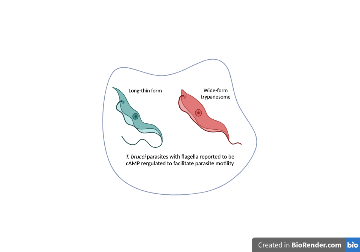T. brucei Phosphodiesterase B1
From Proteopedia
| Line 5: | Line 5: | ||
== Function == | == Function == | ||
'''3′,5′-cyclic nucleotide phosphodiesterases (PDEs)''' are enzymes that hydrolyse 3',5'-phosphodiester bonds in two of the most important cell signalling molecules, cyclic-adenosine monophosphates (cAMPs) and cyclic-guanosine monophosphates (cGMPs). PDEs are essential for the inactivation of cAMP and or cGMP to regulate their intracellular concentrations and maintain cellular homeostasis <ref>PMID:21176056</ref>. PDEs directly modulate these messenger molecules by degrading cAMP or cGMP when concentrations are elevated beyond the cellular threshold <ref>PMID:29672041</ref>. <scene name='90/908690/Tbrpdeb1whole/1'>Phosphodiesterase B1</scene> is one of two cyclic nucleotide phosphodiesterases (the other is TbrPDEB2) that have been validated as promising drug targets for the treatment of human African trypanosomiasis, a life-threatening infectious disease also known as sleeping sickness which is caused by ''Trypanosoma brucei'' parasites <ref>PMID:23409953</ref>. PDEB1 is a cAMP-specific [[hydrolase]] that catalyses the hydrolysis of cAMP to AMP. This enzyme has been reported to play a major role in facilitating ''Trypanosoma'' motility in host cells and subsequent progression through the parasite life cycle <ref>PMID:30778051</ref>. | '''3′,5′-cyclic nucleotide phosphodiesterases (PDEs)''' are enzymes that hydrolyse 3',5'-phosphodiester bonds in two of the most important cell signalling molecules, cyclic-adenosine monophosphates (cAMPs) and cyclic-guanosine monophosphates (cGMPs). PDEs are essential for the inactivation of cAMP and or cGMP to regulate their intracellular concentrations and maintain cellular homeostasis <ref>PMID:21176056</ref>. PDEs directly modulate these messenger molecules by degrading cAMP or cGMP when concentrations are elevated beyond the cellular threshold <ref>PMID:29672041</ref>. <scene name='90/908690/Tbrpdeb1whole/1'>Phosphodiesterase B1</scene> is one of two cyclic nucleotide phosphodiesterases (the other is TbrPDEB2) that have been validated as promising drug targets for the treatment of human African trypanosomiasis, a life-threatening infectious disease also known as sleeping sickness which is caused by ''Trypanosoma brucei'' parasites <ref>PMID:23409953</ref>. PDEB1 is a cAMP-specific [[hydrolase]] that catalyses the hydrolysis of cAMP to AMP. This enzyme has been reported to play a major role in facilitating ''Trypanosoma'' motility in host cells and subsequent progression through the parasite life cycle <ref>PMID:30778051</ref>. | ||
| + | |||
| + | [[Image:T._brucei_parasite_image.png|alt text]] | ||
== Relevance == | == Relevance == | ||
Revision as of 10:33, 6 April 2022
T. brucei PhosphodiesteraseB1
|
Contents |
Function
3′,5′-cyclic nucleotide phosphodiesterases (PDEs) are enzymes that hydrolyse 3',5'-phosphodiester bonds in two of the most important cell signalling molecules, cyclic-adenosine monophosphates (cAMPs) and cyclic-guanosine monophosphates (cGMPs). PDEs are essential for the inactivation of cAMP and or cGMP to regulate their intracellular concentrations and maintain cellular homeostasis [1]. PDEs directly modulate these messenger molecules by degrading cAMP or cGMP when concentrations are elevated beyond the cellular threshold [2]. is one of two cyclic nucleotide phosphodiesterases (the other is TbrPDEB2) that have been validated as promising drug targets for the treatment of human African trypanosomiasis, a life-threatening infectious disease also known as sleeping sickness which is caused by Trypanosoma brucei parasites [3]. PDEB1 is a cAMP-specific hydrolase that catalyses the hydrolysis of cAMP to AMP. This enzyme has been reported to play a major role in facilitating Trypanosoma motility in host cells and subsequent progression through the parasite life cycle [4].
Relevance
PDEB1 makes an interesting drug target as it is an essential parasite protein.
Structural highlights
This is a sample scene created with SAT to by Group, and another to make of the protein. You can make your own scenes on SAT starting from scratch or loading and editing one of these sample scenes.
</StructureSection>
Citations
- ↑ Baker DA. Cyclic nucleotide signalling in malaria parasites. Cell Microbiol. 2011 Mar;13(3):331-9. doi: 10.1111/j.1462-5822.2010.01561.x. Epub, 2010 Dec 28. PMID:21176056 doi:http://dx.doi.org/10.1111/j.1462-5822.2010.01561.x
- ↑ Blaazer AR, Singh AK, de Heuvel E, Edink E, Orrling KM, Veerman JJN, van den Bergh T, Jansen C, Balasubramaniam E, Mooij WJ, Custers H, Sijm M, Tagoe DNA, Kalejaiye TD, Munday JC, Tenor H, Matheeussen A, Wijtmans M, Siderius M, de Graaf C, Maes L, de Koning HP, Bailey DS, Sterk GJ, de Esch IJP, Brown DG, Leurs R. Targeting a Subpocket in Trypanosoma brucei Phosphodiesterase B1 (TbrPDEB1) Enables the Structure-Based Discovery of Selective Inhibitors with Trypanocidal Activity. J Med Chem. 2018 May 1. doi: 10.1021/acs.jmedchem.7b01670. PMID:29672041 doi:http://dx.doi.org/10.1021/acs.jmedchem.7b01670
- ↑ Jansen C, Wang H, Kooistra AJ, de Graaf C, Orrling KM, Tenor H, Seebeck T, Bailey D, de Esch IJ, Ke H, Leurs R. Discovery of Novel Trypanosoma brucei Phosphodiesterase B1 Inhibitors by Virtual Screening against the Unliganded TbrPDEB1 Crystal Structure. J Med Chem. 2013 Mar 1. PMID:23409953 doi:http://dx.doi.org/10.1021/jm3017877
- ↑ Shaw S, DeMarco SF, Rehmann R, Wenzler T, Florini F, Roditi I, Hill KL. Flagellar cAMP signaling controls trypanosome progression through host tissues. Nat Commun. 2019 Feb 18;10(1):803. doi: 10.1038/s41467-019-08696-y. PMID:30778051 doi:http://dx.doi.org/10.1038/s41467-019-08696-y

